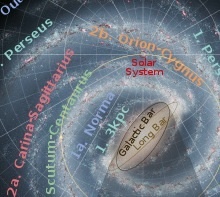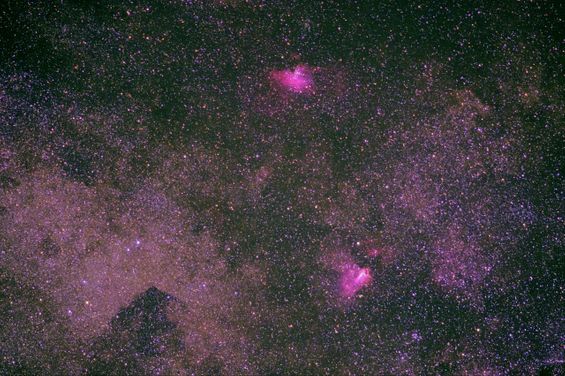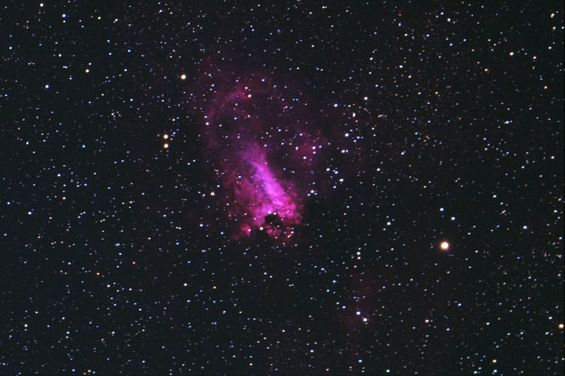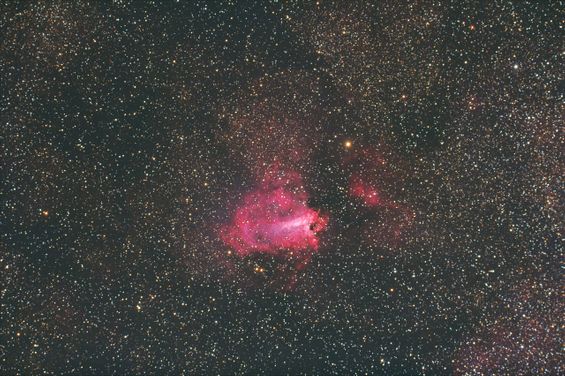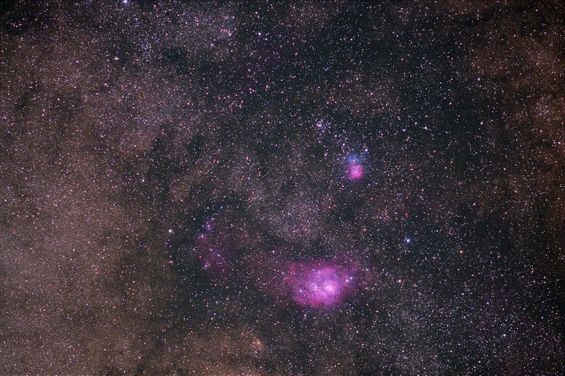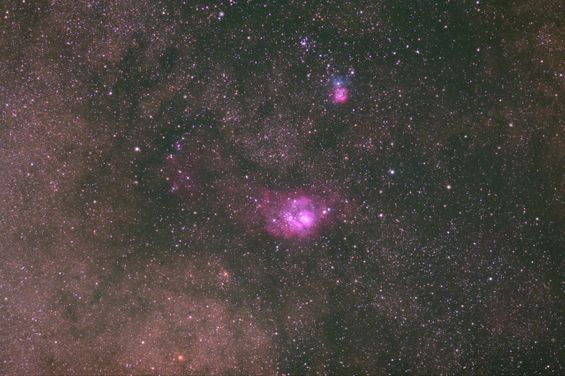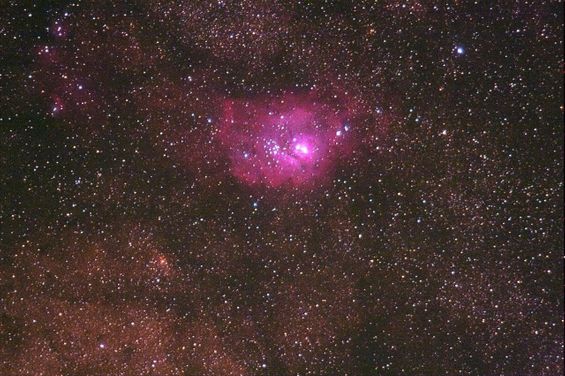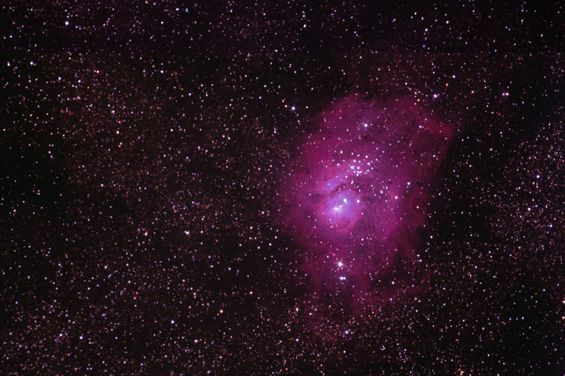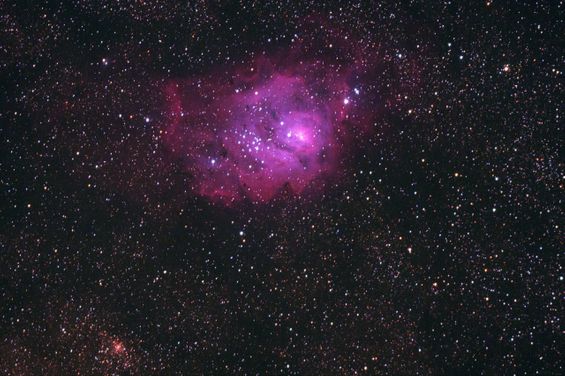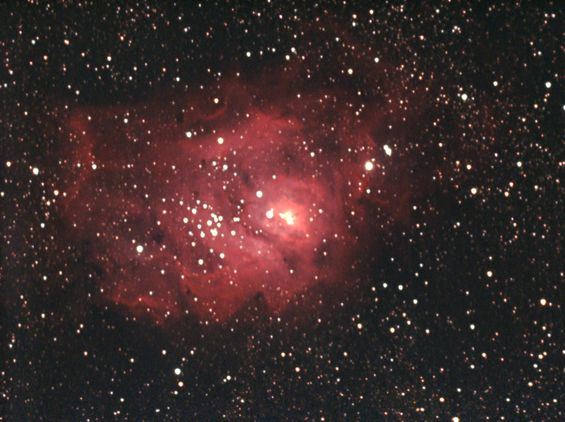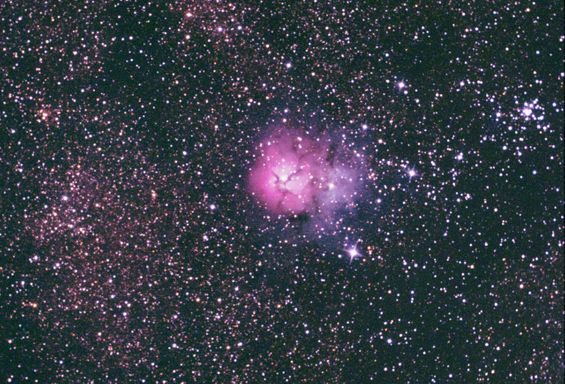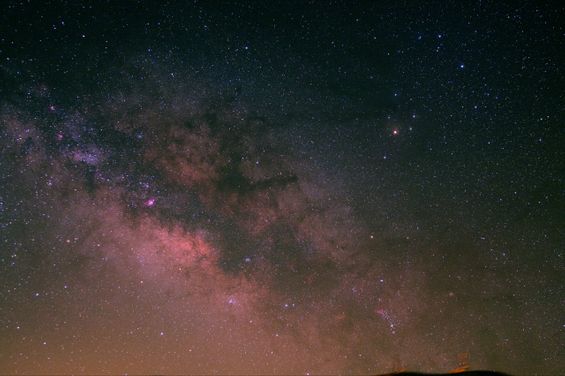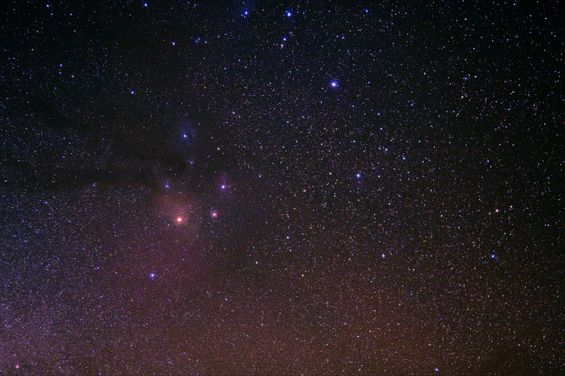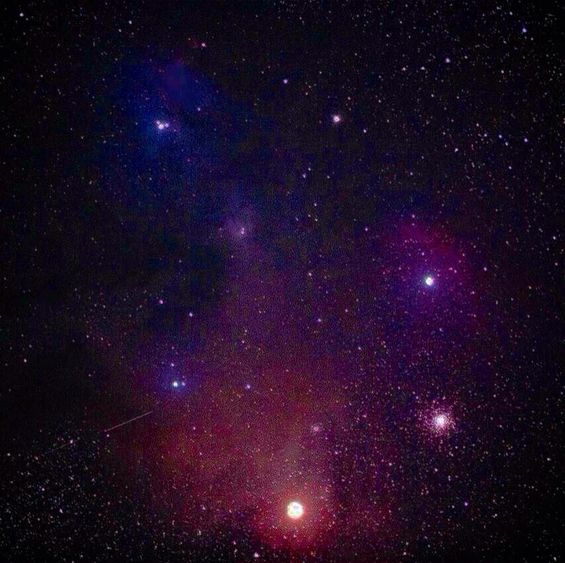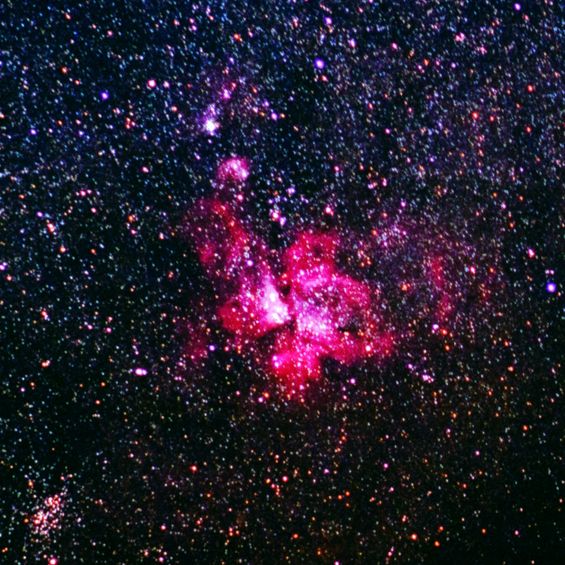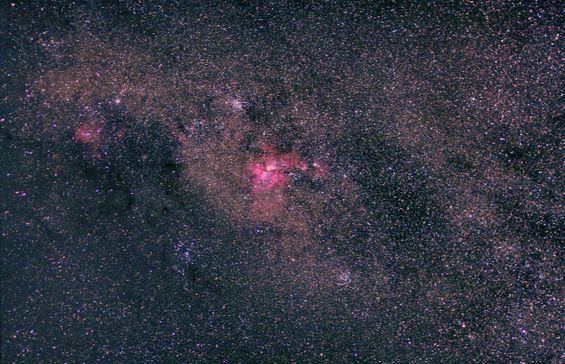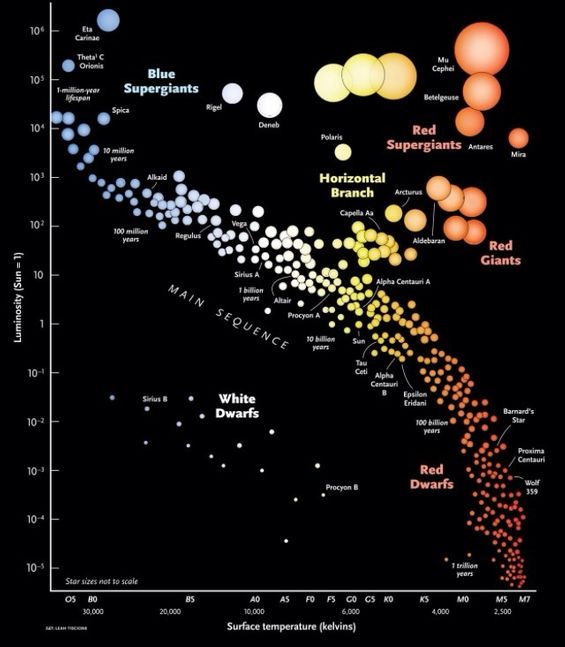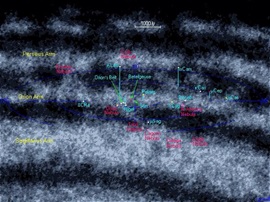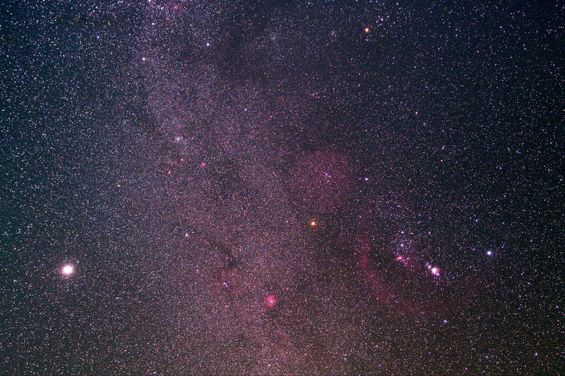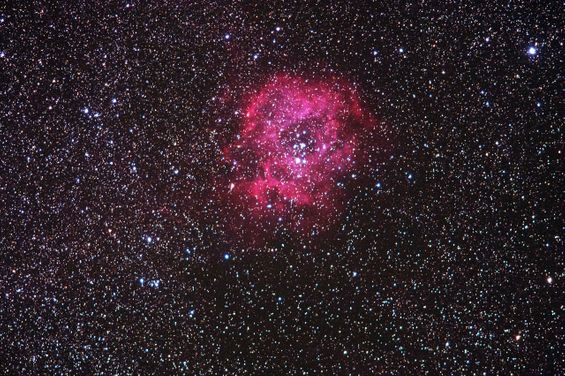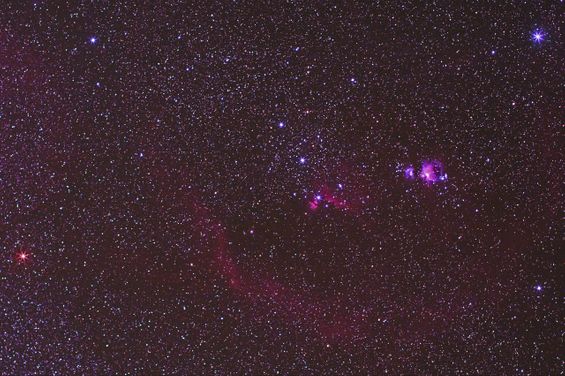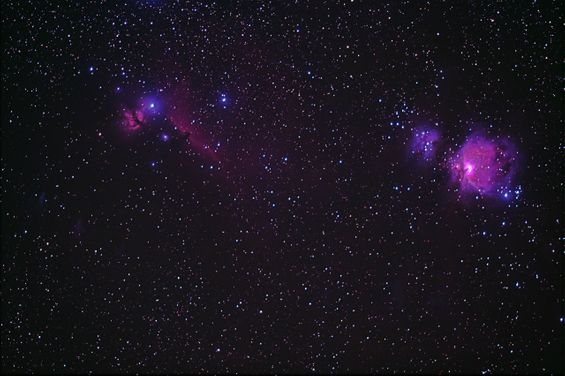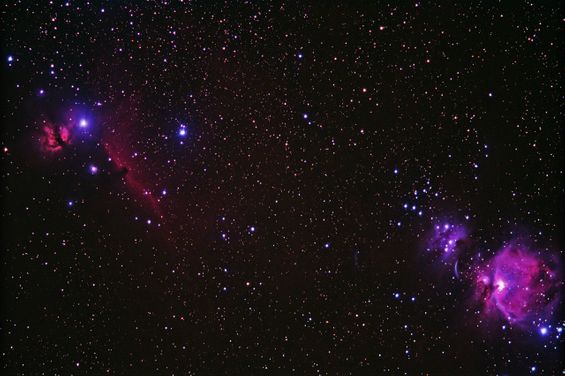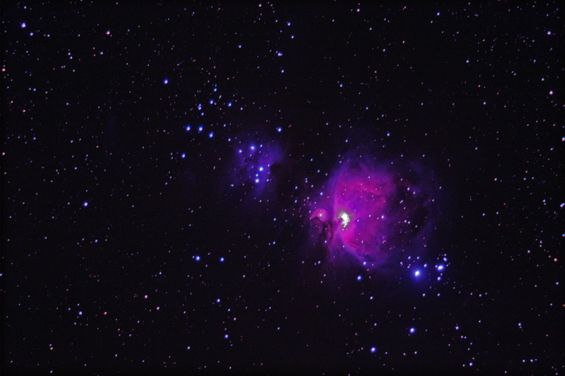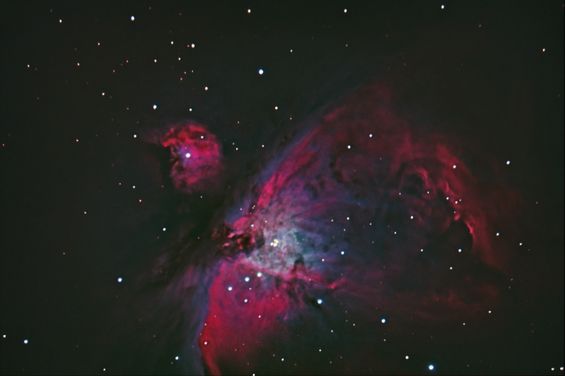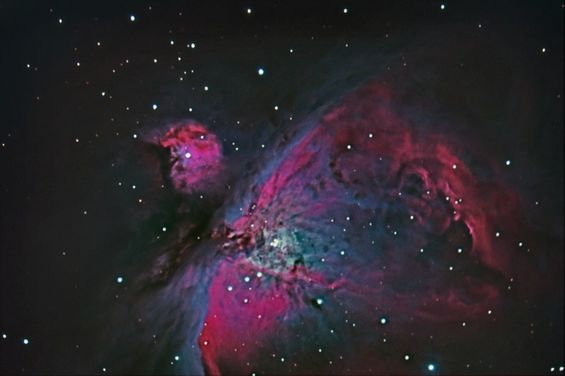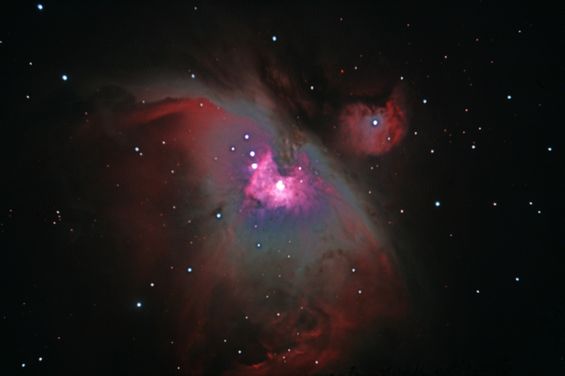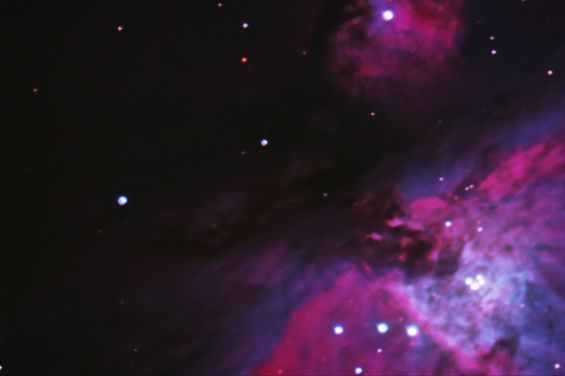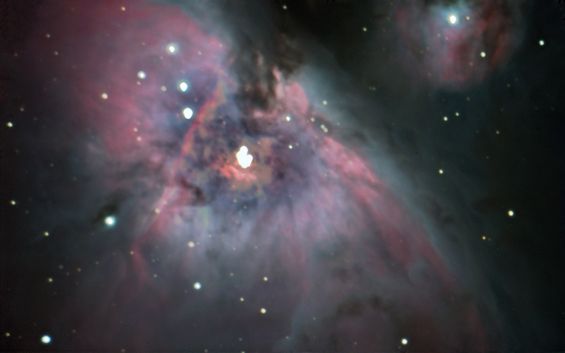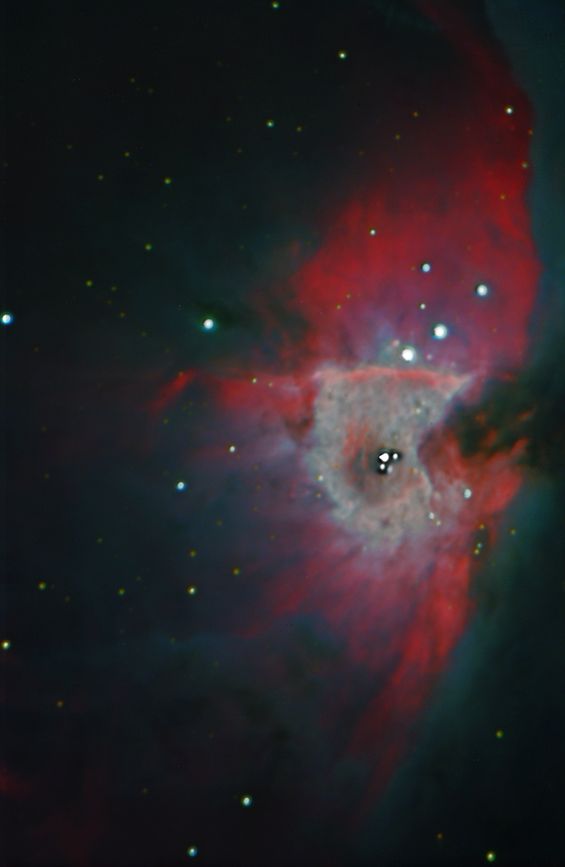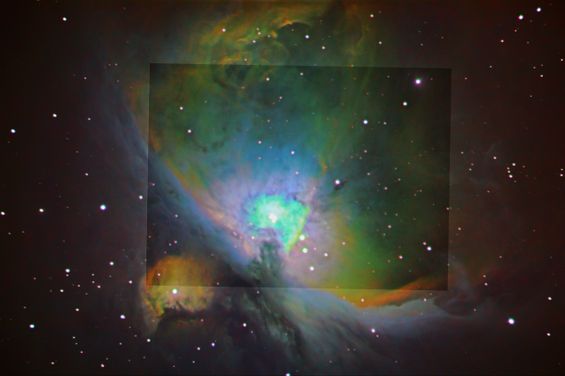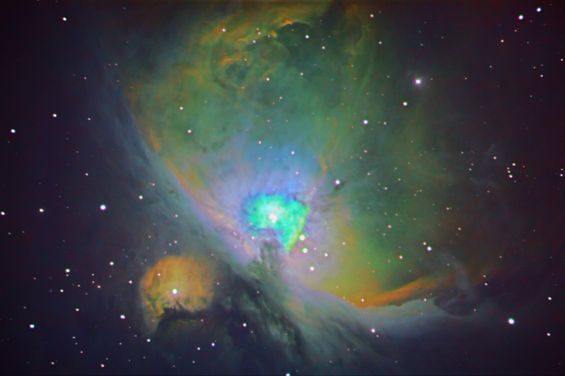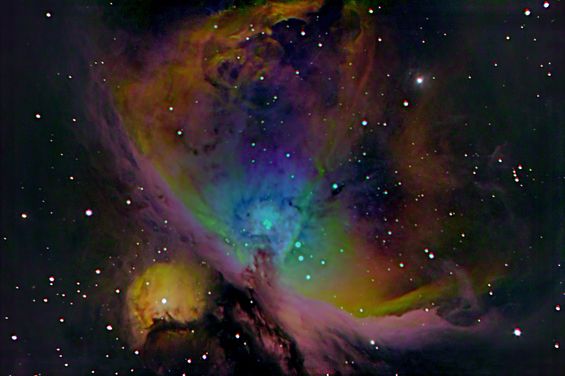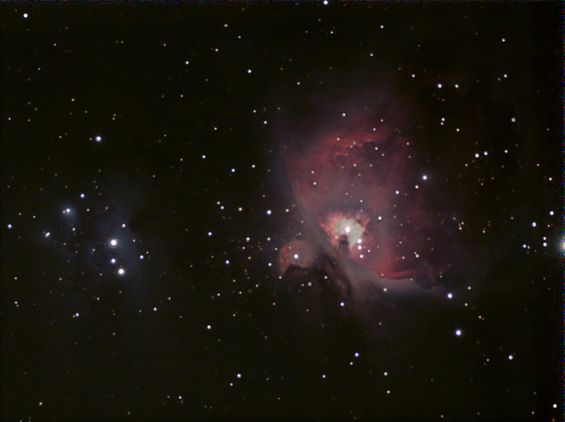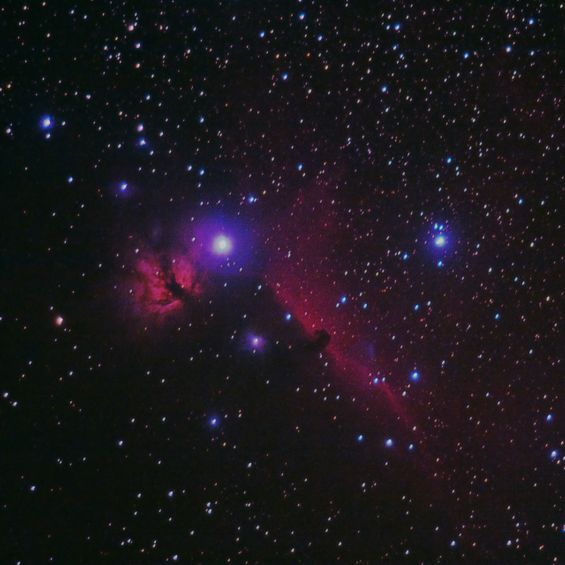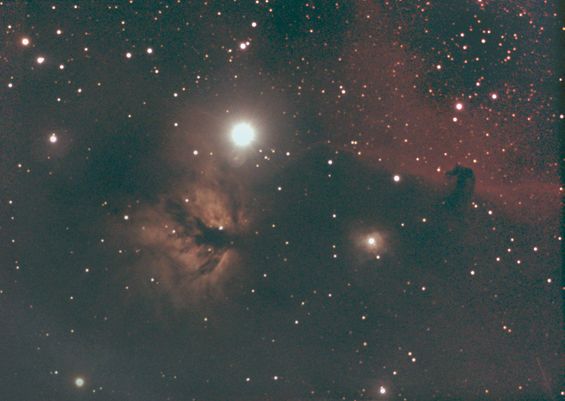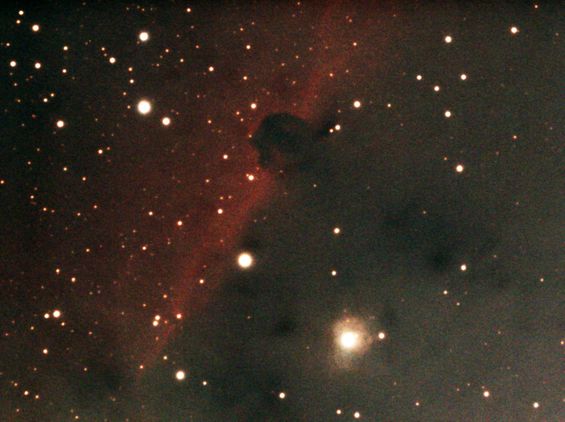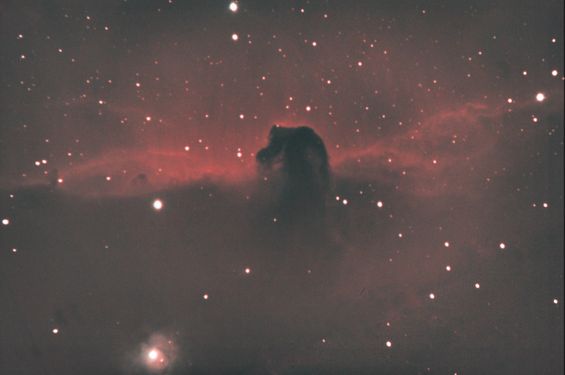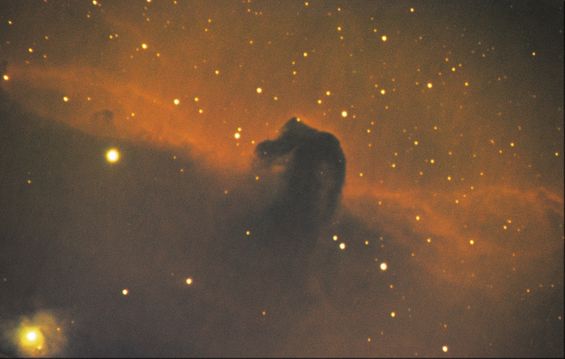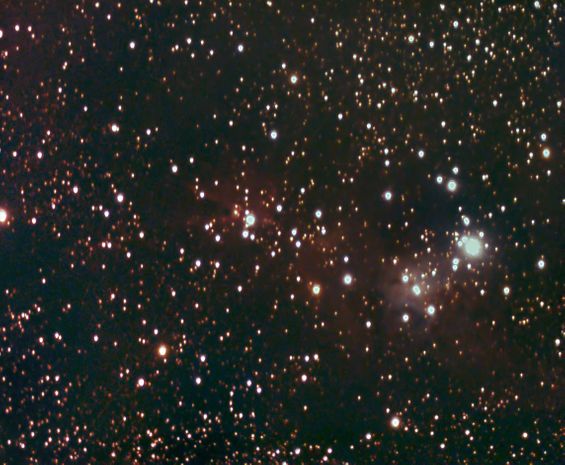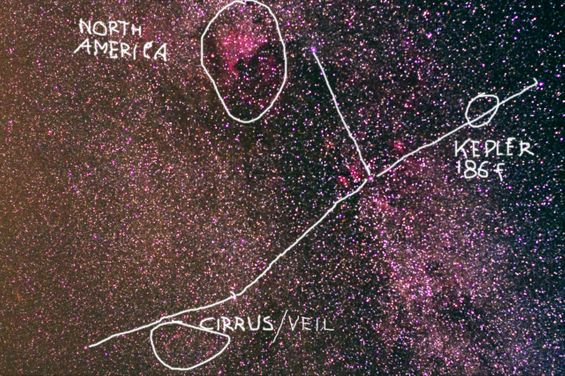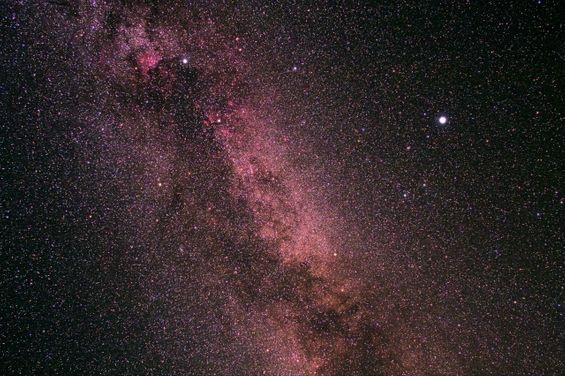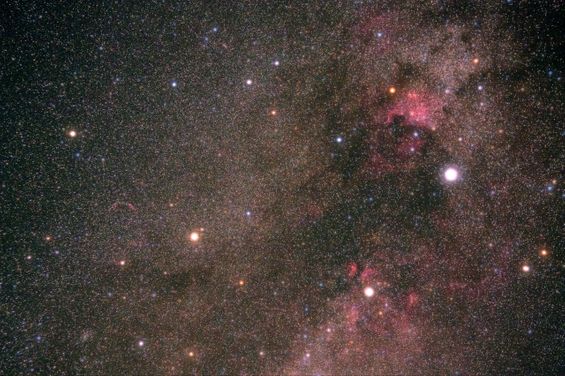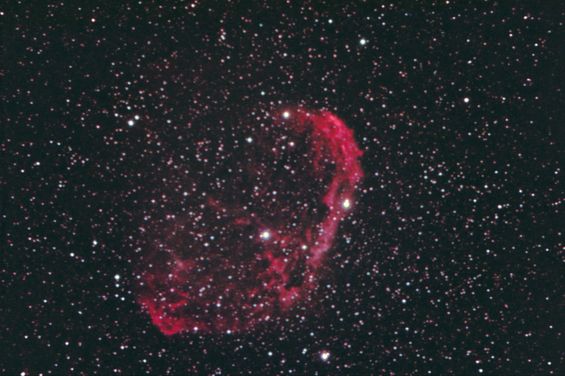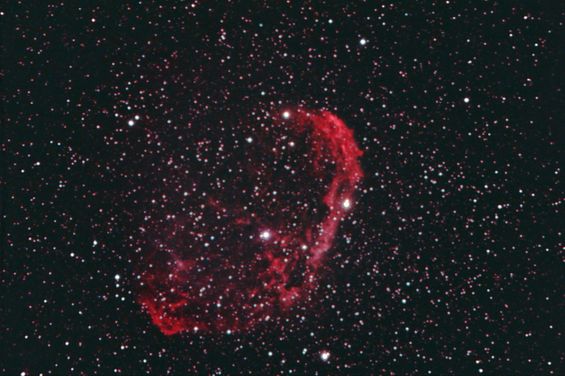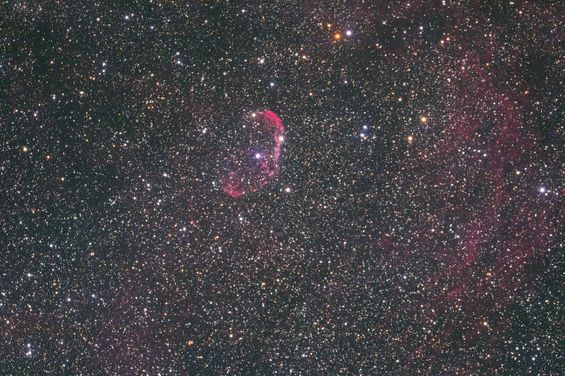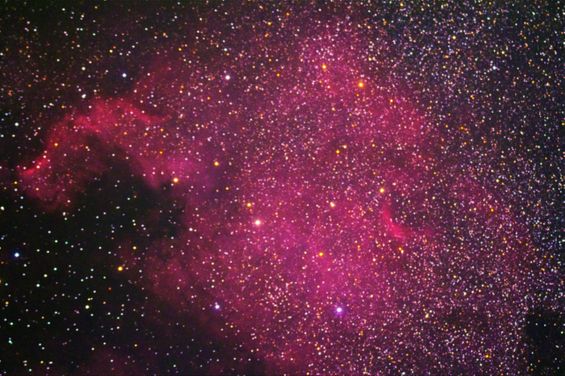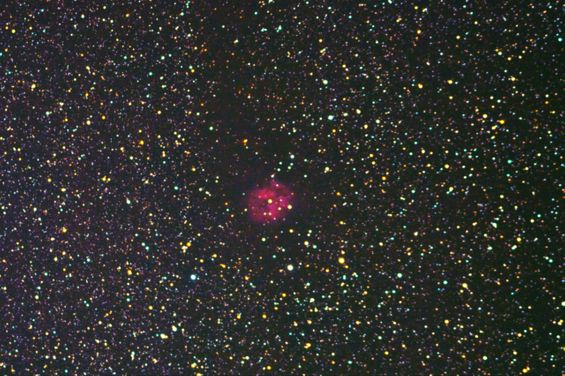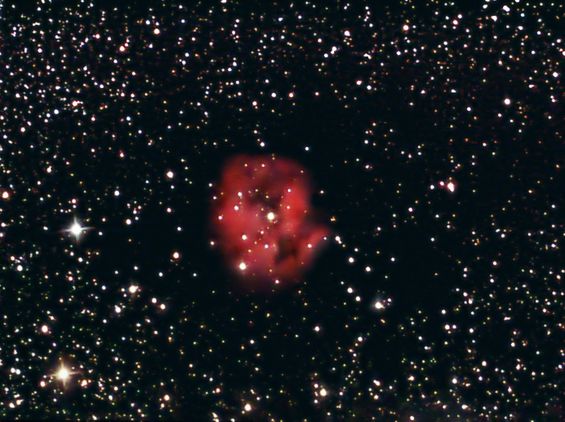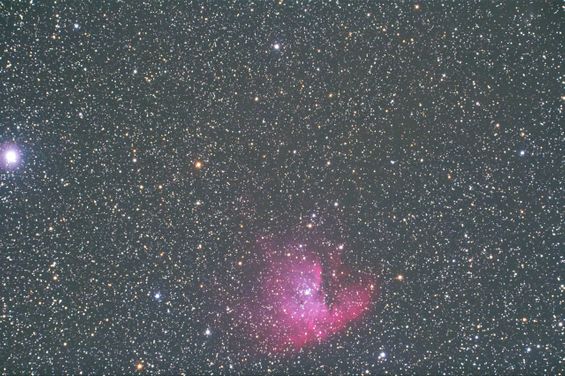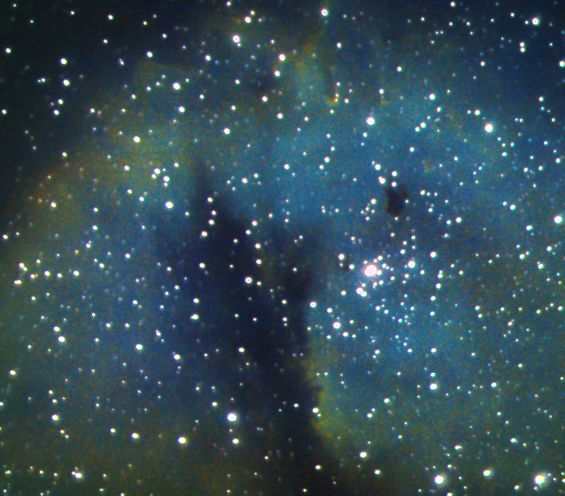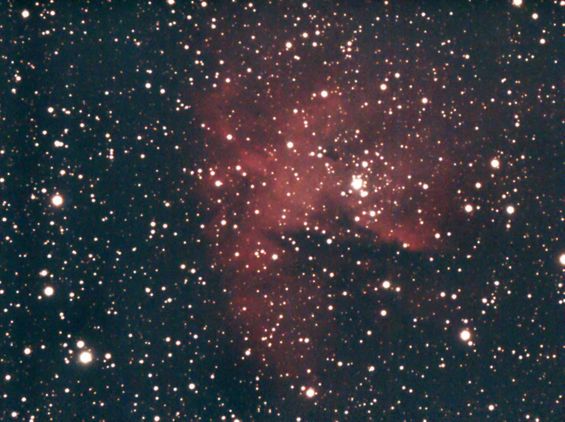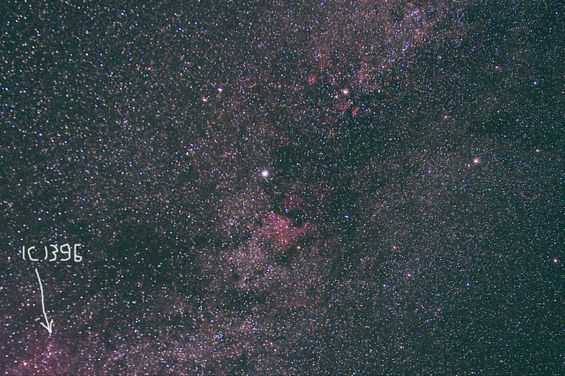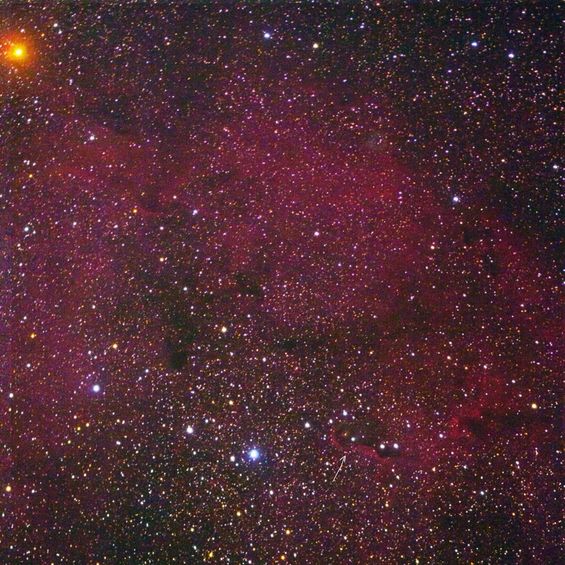nebulae in the spiral arms of our Milky Way
Visit also our mobile webpage
Sagittarius-Carina spiral arm
The nebulae on this spiral arm are between 4000 and 9000 lightyears away from us. The Sagittarius-Carina spiral arm is the next spiral arm in direction to the center of our galaxy; closer to the center than our own Orion-Cygnus arm where the Sun is drifting.(See drawing, source internet)
The big 4 nebulae of the summer southern Milky Way, Eagle, Omega, Trifid and Lagoon. The 4 nebulae are 4000 to 5000 lightyears away from us Astro photo taken on Emberger Alm Carinthia using Canon 24-105 L lens Enjoy also the gorgeous structure of our home galaxy!
Eagle Nebula and Omega Nebula in the early summer sky over Alentejo, Portugal Astro photo taken using Canon 200mm L lens on Astrotrac mount!
Eagle Nebula M 16 Astro photo taken with APM APO 107 700mm and focal reducer at F5,1 and Canon EOS 550dmod 2x7min at ISO 1600
Eagle Nebula M 16 Astro photo taken with APM APO 107 700mmat F6,5 and Canon EOS 550dmod 3x8min at ISO 1600 at Emberger Alm, Carinthia
Detail of M 16, the Eagle Nebula. In the right center you can see the so called Pillars of Creation. They are so named because the gas and dust are in the process of creating new stars, while also being eroded by the light from nearby stars that have recently formed. The pillars, composed entirely of gas and dust, have such high densities that the resulting gravity causes the gas to contract and form stars.(Wikipedia). The pillars reach out at a lenght of 4 lightyears which corresponds to the distance between our Sun and the star next to us(Proxima Centauri). Astro photo taken with Celestron C 14, focal reducer Luminance: Canon EOS 450d monochrome 3x8minutes and 1x13min ISO 1600 and UHC filter RGBand Canon Eos 600d modified. Stack of 5 photos partly using CLS, UHC and Halpha filters respectively at 1600 ISO. Astrophoto C14
Omega Nebula M17 taken with80/480 triplet APO at Hadres, wine quarter(Weinviertel) Lower Austria.
Omega Nebula M 17 Astro photo taken with APM APO 107 700mm and focal reducer at F5,1 and Canon EOS 550dmod 5x7min at ISO 1600
Lagoon and trifid nebulae embedded in the summer Milky Way and accompanied by some global clusters drifting around the center of our home galaxy Astro photo taken using a Canon 200mm L lens on Astrotrac mount Rhodos Island Greece
Laguna and Trifid Nebulae over the mountain plateau of Hohe Dirn Upper Austria taken with Canon 450d Monochrome and EOS 40d modified and Canon 200mm 2,8 L lens 9 exp 250 sec each at ISO 800 on Astrotrac
Lagoon and Trifid Nebulae M8 and M20 taken with 80/480 Triplet APO and 0,79 reducer on Astrotrac mount using Canon EOS 550d modified 3x3minutes at ISO 1600
Lagoon nebula 4500 lightyears away diameter about 60 lightyears embedded in the summer Milky Way and accompanied by global cluster Astro photo taken using a Canon 200mm L lens and 2x tele converter on Astrotrac Mount at Rhodos Island Greece
Messier 8, Lagoon Nebula, a red emission nebula Astro photo taken with Skywatcher Newton 0,6m focal length and 13cm aperture on EQ3 mount guided by MGEN on the south coast of Crete Greece
Lagoon nebula M 8 taken with 80/480 APO Triplet on Astrotrac mount at Lissiya resort Southern Turkey coast.
Lagoon Nebula M8 Astro photo taken with 80 480 APO and 0,79 reducer and Atik Infinity at Star Park Hohe Dirn Upper Austria. Stack of 100 exp 5 sec each on azimuthal mount
Trifid Nebula M20 Astro photo taken with 80 480 APO and 0,79 reducer and Atik Infinity at Star Park Hohe Dirn Upper Austria. Stack of 100 exp 5 sec each
Messier 20, Trifid Nebula, 4000 lightyears away, diameter about 20 lightyears(approx same size as Orion Nebula but three times it's distance) , consists of a red emission nebula and a blue reflection nebula. Isn't the structure beautiful?! Astro photo taken with Skywatcher Newton 0,6m focal length and 13cm aperture on EQ3 mount guided by MGEN on the south coast of Crete Greece Magnified detail
Milky Way over Fuerteventura, Spain with Sagittarius(left) and Rho Ophiuchus region(top right). You can see also the Pipe dark nebula(center) and the Prawn nebula(over the horizon). Astro photo taken using Canon L lens 24-105mm.
Rho Ophiuchus region(description see next photo). Astro photo taken using Canon L lens 24-105mm on the island of Fuerteventura, Spain.
Rho Ophiuchus region, red emission nebulae and blue and yellow reflection nebulae illuminated by blue and red/yellow shining stars. The red/yellow shinig star on the bottom is Antares, a red giant, 600 lightyears away(see also the size comparison to our Sun below and Hertzsprung-Russel diagram below), on the right hand side you can see the globular cluster M4, 7000 lightyears away, and above the blue giant star Al Niyat, 730 lightyears away, which is illuminating a red emission nebula. Left on top of the photo of the Rho Ophiuchi Area a blue reflexion nebula illuminated by Rho Oph., a blue main sequence triple star, 400 lightyears away. Astro photo taken using a Canon 200mm L lens Alentejo Portugal An incredible explosion of colors created by Mother Nature. See also section star clusters for M4.
Comparison of size between our Sun and the red supergiant Antares
The Eta Carinae Nebula, a giant gas cloud not far from the Southern Cross 9000 lightyears away about 300 lightyears diameter, i.e. Nearly double the distance of lagoon nebula and about five times it's size. It's also located on the Sagittarius-Carina spiral arm of our Milky Way like the lagoon nebula. The star Eta Carinae embedded in the nebula is a giant blue variable star(see Hertzsprung-Russel diagram below). It measures about 100-120 sun masses and is of variable brightness. It survived an eruption in 1843 during which it's brightness rose to -0,8mag, at this time the second brightest star after Sirius. Then it's brightness has reduced and has ranged between +8 and +5, which is on the border of visibility for the naked eye. The eruption in 1843 is called supernova impostor and in fact is an extra powerful nova(see also section novae). However Eta Carinae is a hot candidate for the next supernova explosion in our galaxy. It could happen any time although some scientist give the star a remaining life span of another 10.000 years. The last supernova in our galaxy took place about 1000years ago( see section supernovae). The nebula can be seen only from locations on the Southern Hemisphere or close to the equator Picture taken in Costa Rica using using a Canon 85 mm lens,magnified detail
Eta Carinae Nebula and the open clusters NGC 3114 and NGC 3532 taken at Anantara Si Kao Resort, Trang Thailand , Canon EOS 40d modified and 24-105mm L
Eta Carinae Nebula NGC 3372, Running Chicken Nebula IC 2944, open cluster NGC 3532(above) and the open cluster Southern Plejades NGC IC 2602(below). Astro photo taken with Canon EOS 40d modified and Canon 1:1,4 50mm at f 2 using 800ISO, 5x2min at Chale Island coast of Kenya
The Hertzsprung-Russel Diagram depicts logarithmic luminosity of observed stars against their surface temperature. Stars belonging to the main sequence show increasing luminosity with increasing surface temperature. Generally speaking the hot blue stars have a much shorter lifespan. The red giant stars show high luminosity although their surface temperature is lower simply because of their incredible size! Our sun is an average main sequence star in the center of the diagram. Antares is a red giant star on the top right, and Eta Carinae a blue giant star on the top left. Due to the logarithmic scale Antares luminosity is 4million times the Sun!! The sizes of the stars in this diagram don't reflect the real differences in size; Eta Carinae's diameter us 80-180 times the Sun and Antares has a diameter of 820 times our Sun. Source Internet Sky And Telescope
Orion-Cygnus and Perseus spiralarms
10The nebulae on the Orion-Cygnus spiral arm of our galaxy where also we and our Sun are drifting, are the closest to us and are 900 to 2500 lightyears away.
The nebulae
on the Perseus spiral arm which is farer away from the center of our Milky Way than our Orion-Cygnus arm, are about 4000 to 10000 lightyears away and are seen from Earth in the same direction as the Orion-Cygnus
arm. Therefore both spiral arms are presented in the same chapter.
see also drawing, source internet
Constellations Orion, Monoceros, Gemini and Auriga and the beautiful Milky Way over Death Valley. You see the Orion and the Perseus spiral arms. Astro Photo taken with Sigma 1:1,8 20mm and Canon
Description of the astro photo above: Jupiter, Conus nebula, Rosette nebula, Barnards Loop, Horsehead nebula, Orion nebula, Withchead nebula(see section supernovae), open cluster M 35, emission nebula NGC 2174, emission nebulae IC 405 and IC 410 in Auriga. Whereas the nebulae in Orion and the star cluster M35 f.ex. belong to our Orion-Cygnus spiral arm, the Rosette nebula forms part of the farer away Perseus arm!!
Rosette Nebula in constellation Monoceros 4700 lightyears away and about 120 lightyears diameter, I.e. About same distance and double size of lagoon nebula and located on the outer Perseus arm of our Milky Way A beautiful hydrogen reflection nebula with an embedded open star cluster being the light source for the red reflection and also resulting from star formation in this cloud astrophoto taken using a Canon 200mm L tele Lens on Astrotrac mount Death Valley South West USA stunning beauty like a creation from an artist and creational processes stemming from this objects 5200 light years away from earth!!
constellation Orion with Barnards Loop, Horsehead Nebula and Orion Nebula. The Orion nebula is located on our Orion spiral arm Astro photo taken with Canon 1:1,4 50mm lens in Death Valley,
Orion nebula, Running Man Nebula and horsehead nebula in the constellation Orion Astro photo taken using a Canon 200mm L lens in Death Valley
Orion nebula, Running Man Nebula and horsehead nebula in the constellation Orion Astro photo taken using a Canon 200mm L lens and 1,4 converter Borego State Park South East California
Orion nebula and Running Man Nebula in the constellation Orion 1400 lightyears away about 23 lightyears diameter it's located on the same spiral arm of the Milky Way as our Sun and us. Only about half the size of lagoon nebula Astro photo taken using a Canon 200mm L lens and 2x converter ON Astrotrac mount Borego State Park South East California
Orion Nebula and Running Man Nebula taken with Explore Scientific APO Triplet 80/480 and Canon on Astrotrac mount!! in Lower Austria not far from Vienna on Christmas Eve 2013 Cool or what so close to the city lights Nearly as good as the ones from the Borego Desert in Southern California. Maybe the next travel setup
The Orion Nebula An explosion of colors Astro photo taken with a Celestron C I 14 using a focal reducer 30km east of Vienna, Austria Stars are born in this area!! It's the closest major star creating machine to our earth Astrophoto C14
Orion Nebula M42 taken one day after full móon stack of 6 exposures using Halpha, OIII, UHC and CLS filters respectively ISO 800, exp 1-4minutes with Celestron C14 focal reducer at f7 and Canon EOS 600d mod.
Orion nebula M42, composite of the both astro photos above.
Orion Nebula M42 taken with Celestron C14 with reducer f7 at F=2500mm and Color CCD Camera Orion Star Shoot Pro V2. stack of 14 exp,using CLS, UHC and OIII filters between 200 and 400 sec each.
Composite of the CCD image and the Eos image above astrophoto C14
Orion Nebula, close up astro photo using Celestron C 14 At F=4m and Canon, composite with the astro above using Halpha, OIII and UHC filters. like an abstract modern painting created by nature! Astrophoto C14
Orion Nebula taken with Celestron C14 and Orion Starshoot Pro Color CCD Camera
Orion Nebul M42 Astro photo taken with Celestron C14 and Orion Starshoot Pro CCD Camera stack of: 2x2 binning mono: 30sec, 100sec and 200sec 1x1 color: 100sec, 200sec and 400sec
Orion Nebula Comparison between the chip size of the EOS 450d monochrome and the SBIG 2000xm monochrome CCD camera
Orion Nebula M42. astrophoto taken with Celestron C14 and reducer at f7, F2500mm, Hubble colors EOS 450d monochrome stack of: luminance: 6exp a 5min CLS, 3exp a 70sec CLS, 3exp a 30 sec CLS Halpha: 3exp a 10 min GREEN OIII: 3exp a 10min BLUE SII: 3exp a 10min RED
Orion Nebula M42. astrophoto taken with Celestron C14 and reducer at f7, F2500mm EOS 450d monochrome stack of: luminance: 6exp a 5min CLS, 3exp a 70sec CLS, 3exp a 30 sec CLS Halpha: 3exp a 10 min RED OIII: 3exp a 10min BLUE SII: 3exp a 10min GREEN
close up of the Running Man Nebula NGC 1973,1975,1977, a Reflexion nebula 1500 lightyears away, north of the Orion nebula using Celestron C 14, a focal reducer and Canon. Astrophoto C14
Orion Nebula M42 and Running Man Nebula astro photo taken with Atik Infinity and 80/480 APO reducer 0,79 stack of 50x10 sec, 50x1sec, 50x0,1sec
The Orion Belt with M42,M43(Running Man Nebula) and Horsehead Nebula Astro photo taken with Canon 40d and 1:2,8 200mm L Lens on Astrotrac mount on the island of Curacao.1stack of 10 exposures between 5 sec and 120 sec at ISO 800
Horsehead nebula in the constellation Orion 1500 light years away Astro photo taken using a Canon 200mm L lens and 2x converter Borego State Park South East California
Horsehead Nebula astro photo taken with Atik Infinity and 80/480 APO reducer 0,79 stack of 50x10 sec, 50x1sec, 50x0,1sec
Horsehead Nebula Astro photo taken with APM APO 107/700 and Atik Infinity 50x10sec
Horsehead Nebula Astrophoto taken with Celestron C14 with focal reducer at f7 using Canon EOS 450d monochrome luminance: 4x7min CLS 1600ISO halpha 3x15 min and 1x20min 1600ISO
Horsehead Nebula Astrophoto taken with Celestron C14 with focal reducer at f7 using Canon EOS 450d monochrome luminance: 4x7min CLS 1600ISO halpha 3x15 min and 1x20min 1600ISO
Horsehead Nebula Astrophoto taken with Celestron C14 and SBIG 2000xm Halpha: 2x2000sec 1x1binning G;B: 3x300sec 2x2binning Astrophotography
Conus nebula in Monoceros, 2700 light years away, over Death Valley, USA. Astro photo taken using a Canon 200mm L lens.
Conus nebula in Monoceros over Borego desert, USA Astro photo taken using a Canon 200mm L lens + 1,4x tele converter
Conus nebula in Monoceros. On the bottom you can see the so called Christmas tree clusterand the tree topper star; in the right center there is the fox fur nebula. Astro photo taken usin 8 inch f4 Newton at Emberger Alm, Carinthia, Austria.
Christmas Tree Cluster taken with Atik Infinity and 80/480 APO reducer 0,79 stack of 50x20 sec
The flaming star nebula IC 405, a red emission and blue reflection nebula 1500 lightyears away in constellation Auriga (top), and the emission nebula IC 410(below) You can also see the open cluster M 38,4500 lightyears away(bottom left) Astro photo taken using a Canon 200mm L lens in Death Valley, USA
Constellation Cygnus, North America nebula and Cirrus nebula(see section supernovae) and location of the Kepler 186 planetary system where astronomers discovered in April 2014 the first Earth-sized planet in the habitable zone, Kepler 186f. Kepler 186 is a dwarf star about 500 lightyears away. Astro photo taken in Alentejo, Portugal(see news on introtuctory page)
First Earth-size planet in habitable zone discovered: Kepler 186 System link
Summer Milky Way, Orion-Cygnus Spiral Arm with constellations Cygnus(top), Lyra(right) astro photo taken at Emberger Alm using sigma Canon 24-105mm L lens
Constellation Swan with North America, Pelican, Gamma Cygni and Crescent Nebulae and Cirrus or Veil nebulae remnants of a supernova explosion) on the left center part of the pic)- see section supernovae They are also located on our Orion Arm of the Milky Way but in the opposite direction of the Orion Nebula relative to our Sun and us astro photo taken at Emberger Alm using Canon 24-105 L lens
Crescent Nebula NGC 6888 in Cygnus taken with Celestron C14 and focal reducer close to Vienna. luminance: EOS 450d mono stack of 5 exp at ISO 1600,3x11min and 2x15min each using UHC filter; Halpha: EOS 450d mono 3x15min 1600ISO OIII: 3x15min 1600ISO RGB; EOS 40d mod 3x7min CLS filter The crescent nebula is about 4500LY away, 25LY diameter, which is much further away than the other nebulae in the closer vicinity(North America, Gamma Cygni). Its an emission nebula formed by stellar winds ejected from a red giant star
OIII: 3x15min 1600ISO RGB; EOS 40d mod 3x7min CLS filter The crescent nebula is about 4500LY away, 25LY diameter, which is much further away than the other nebulae in the closer vicinity(North America, Gamma Cygni). Its an emission nebula formed by stellar winds ejected from a red giant star
Crescent Nebula NGC 6888 in Cygnus taken with APM APO 107/700 at Emberger Alm. Canon EOS 550d modified, ISO 1600, 3exp 500sec each The crescent nebula is about 4500LY away, 25LY diameter, which is much further away than the other nebulae in the closer vicinity(North America, Gamma Cygni). Its an emission nebula formed by stellar winds ejected from a red giant star
The famous North America Nebula and Pelican Nebula in the Constellation Swan embedded in the Milky Way in the dark, dry skies over Death Valley, USA. 1800 lightyears away and about 65 lightyears diameter more than three times the size of the Orion Nebula Astro photo taken using a Canon 200mm L lens
North America Nebula NGC 7000 taken with80/480 triplet APO at Schrick, wine quarter(Weinviertel) Lower Austria.
Cocoon Nebula in Cygnus, 3200 Lightyears away, diameter 9,3LY taken with 80/480 APO triplet at Hadres, wine quarter(Weinviertel), Upper Austria.
Cocoon Nebula taken with Celestron C14 using a focal reducer at f7 F2500mm close to Vienna luminance: Canon EOS 450d monochrome 1600ISO: 3x600sec UHC, 2x900sec cls, 2x200sec cls RGB: astro photo above taken with 80/480 APO
Cocoon Nebula taken with APM APO 107 700 triplet and Canon EOS 550d modified at Gerlitzen Austria stack of 3 exp a 8min 800ISO
cocoon Nebula astro photo taken with Atik Infinity and Skywatcher 8 inch f4 Newton 200x5sec
Iris nebula NGC 7023, a reflection nebula in constellation Cepheus, astr photo taken using Meade 10inch SC with focal reducer at f 6,3 at Hadres, Weinviertel, Lower Austria
Iris Nebula NGC 7023 in Cepheus taken at the International Telescope Meeeting Internationales Teleskoptreffen Embergaer Alm 2016 stack of 3 exp 552 sec each and 2exp 770sec each with Canon EOS 550d modified ISO 1600, APM APO 107/700 and 0,79 reducer.
Pacman Nebula NGC 281taken with APM APO 107/700 and Canon EOS 550d modifies at Emberger Alm during the ITT 2016. stack of 2 exp 1600 ISO 7min each
detail of the Pacman Nebula NGC 281 in the constellation Cassiopeia with Hubble colors and narrow band filters The nebula lies in the Perseus spiral arm 9500Lightyears away diameter 35 LY Astro photo taken with Celestron C14 and focal reducer Canon EOS 450d monochrome stack of 4 exp 15min each using Halpha filter, 2exp a20min using OIII filter and 4exp 25min each using SII filter all at 1600ISO One can also identify several Bok Globuls which are star creation areas.
Pacman Nebula composite of the two astrophotos above. You can see the advantage of the narrow band filters in Hubble colors showing much more detail as compared to the RGB photo
Pacman Nebula Astrophoto taken with APM APO 107/700mm and Atik Infinity 50x10sec using CLS filter close to Vienna
North America Nebula in Cygnus and Emission nebula IC 1396 in Cepheus taken on the island of Mali Losinj
Emission nebula IC 1396, 2400LY away with the dark globule and star creation area IC 1397A which has a dark red rim called the Elephant Trunk(see arrow) in constellation Cepheus taken with 80/480 Triplet APO at Hadres, wine quarter(Weinviertel), Lower Austria. The star in the upper left is the Gamet Star, the elephant trunk dark nebula runs from the right bottom of the emission nebula to the left. 5 exposures 1600 ISO 5minutes each Canon Eos 600d modified at f6.
California Nebula in Perseus, 1000 lightyears away its apparent size covers 6 full moon disks but its way to faint to be seen by the naked eye astrophoto taken using a Canon 200mm L tele Lens on Astrotrac mount Death Valley South West USA
Close up of California Nebula NGC 7000 APO APM 107 700 with 0,79 reducer on Emberger Alm Stack of 4 exp 330 sec ISO 3200 with Canon 550d mod
John 24.12.2013 14:45
Great project
Congrats
John
Andrew F 24.12.2013 16:59
Hi John
Thanks
Andrew
Neueste Kommentare
22.01 | 09:48
Hi Sani, great that you like it . kind regards Peter
22.01 | 09:34
Thank you for the wonderful and educative information and pictures
18.03 | 19:46
Now I understand Thanks
25.06 | 18:02
I like your mobile website too Hans
